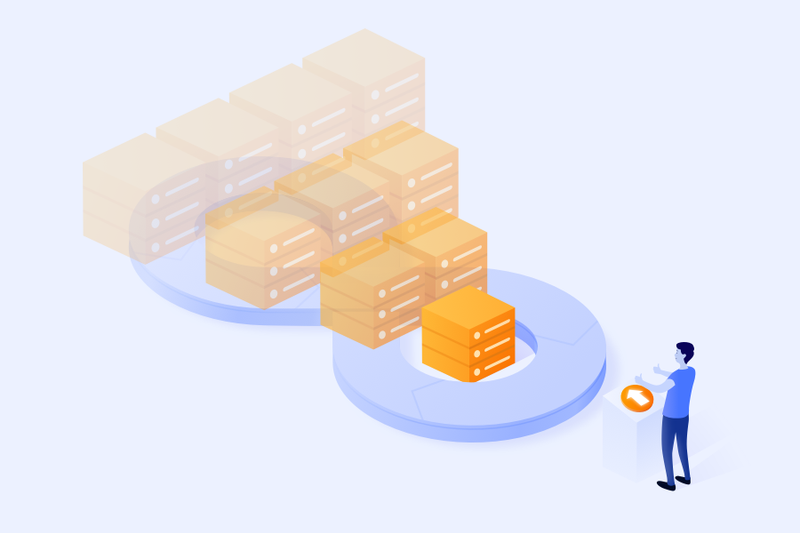Efficient EKS cluster management with AWS Cloud9
Share on socials
Efficient EKS cluster management with AWS Cloud9

Harold (Tre) King
Published on 20 December 2023
8 min read


Harold (Tre) King
Published on 20 December 2023
8 min read
The problem
Managing multi-tenant EKS clusters can be a complex task. Teams are often faced with the challenge of reliably and efficiently managing these clusters using AWS-native services while maintaining a high level of security. This is no small task. Ensuring reliable access, efficient operations, and robust security across multiple tenants requires a well-designed and well-implemented solution.
Our solution
To address this challenge, our team turned to AWS Cloud9. AWS Cloud9 is a cloud-based integrated development environment (IDE) that lets you write, run, and debug your code with a browser. We employed AWS Cloud9 as a management environment for our EKS clusters. This environment could be securely shared with other IAM roles or IAM users within our AWS account, facilitating collaborative work while maintaining secure access.
How does it work?
Our focus was on optimising for security. To achieve this, we selected the AWS Cloud9 IDE service. This service exists within our AWS account, which means it inherits the existing access controls of our AWS console. This integration provides a secure environment for managing our EKS clusters.
Within the Cloud9 environment, we deploy and manage our EKS clusters. We've also detailed how to leverage EKS's role-based access control (RBAC) to segment tenants by namespace. This segmentation allows for fine-grained control over access and resources, ensuring each tenant can operate independently and securely.
Customer experience improvement
Our customers have derived several benefits from this solution. It includes an EKS management environment optimised for secure access via the AWS console, providing a safe, controlled environment for managing EKS clusters. Additionally, the solution leverages AWS Cloud9's shared access management capabilities for IAM roles and IAM users within an AWS account, enabling collaborative work while maintaining secure access. Using EKS's unique IAM role-based RBAC capabilities for multi-tenant EKS clusters offers fine-grained access control, guaranteeing secure, independent operations for each tenant. The solution also incorporates reusable Infrastructure as Code (IaC) templates for rapid deployment and adaptation, facilitating quick and effortless setup and modification of EKS clusters. Lastly, an EKS solution optimised for security is a part of the package, ensuring all operations are conducted securely, protecting our customers and their data.
Deployment instructions
Prerequisite:
- Deploy VPC via CloudFormation template located in this repo:
cfn/vpc-2az.yaml - CloudFormation stack name must be
vpc-2az
Note: VPC subnet selected for Cloud9 must be publicly available.
- Login AWS Console
- Create new Cloud9 environment named "eks-management-env"
- Allow Cloud9 environment setup to complete
Update Cloud9 IAM Role permissions to allow AdministratorAccess
- Use AWS Console and navigate to IAM -> Role -> AWSCloud9SSMAccessRole
- Update existing role AWSCloud9SSMAccessRole by adding IAM permission policy AdministratorAccess
Setup - (CloudFormation)
- Open Cloud9 environment named "eks-management-env"
- In Cloud9, open Preferences -> AWS Settings. Disable the "AWS Manage Temporary Credentials" toggle
- In Cloud9, open a terminal session Clone the GitHub repo for this project:
Unsetgit clone https://github.com/ha-king/eks-cfn.git cd eks-cfn/cfn/bin/sh deploy.sh EKS-DEV us-east-1- Visit CloudFormation service to view the stack status, until status value is CREATE_COMPLETE
cd ../cloud9/bin/sh install_kubectl.sh/bin/sh update-kubeconfig.sh EKS-DEV us-east-1- Run the kubectl get all - A command to view all Kubernetes resources
Clean up:
Unsetawscloudformationdelete-stack--stack-nameEKS-DEV
Setup - (Terraform)
- Open Cloud9 environment named "eks-management-env"
- In Cloud9, open Preferences -> AWS Settings. Disable the "AWS Manage Temporary Credentials" toggle
- In Cloud9, open a terminal session Clone the GitHub repo for this project:
Unsetgit clone https://github.com/ha-king/eks-cfn.git cd eks-cfn/tf/bin/sh deploy.shcd ../cloud9/bin/sh install_kubectl.sh/bin/sh update-kubeconfig.sh EKS-DEV-TF us-east-1- Run the
kubectl get all- A command to view all Kubernetes resources
Clean up:
Unsetcd tf
terraformdestroy--auto-approve
Sharing Cloud9 Environment
- To invite an IAM user, enter arn:aws:iam::123456789012:user/MyUser. Replace 123456789012 with your AWS account ID and replace MyUser with the name of the user.
- To invite a user with an assumed role or a federated user with an assumed role, enter arn:aws:sts::123456789012:assumed-role/MyAssumedRole/MyAssumedRoleSession.
- To invite the AWS account root user, enter arn:aws:iam::123456789012:root. Replace 123456789012 with your AWS account ID.
Example:
Unset
Unset
awscloud9create-environment-membership--environment-id1234567890987654321--user-arnarn:aws:iam::123456789098:root--permissionsread-writeSetup - EKS Admin IAM entities
kubectl edit cm/aws-auth -n kube-system- Reference the aws-auth configuration map below:
Unset# Please edit the object below. Lines beginning with a '#' will be ignored,
# and an empty file will abort the edit. If an error occurs while saving this file will be
# reopened with the relevant failures.
#
apiVersion: v1
data:
mapRoles: |
- groups:
- system:bootstrappers
- system:nodes
rolearn: arn:aws:iam::123456789098:role/eks-dev-EksNodeWorkerRole-123456789
username: system:node:{{EC2PrivateDNSName}}
- groups:
- system:masters
rolearn: arn:aws:iam::123456789098:role/eks-dev-EksRbacAdminRole-123456789
username: ec2-admin
- groups:
- system:masters
rolearn: arn:aws:iam::123456789098:role/my-role-name
username: my-admin
mapUsers: |
- groups:
- system:masters
userarn: arn:aws:iam::123456789098:user/my-user
username: my-user
kind: ConfigMap
metadata:
creationTimestamp: "2023-05-25T17:32:16Z"
name: aws-auth
namespace: kube-system
resourceVersion: "21552"
uid:13e8d1d3-c6a1-4369-aff8-e58e94572ad3
EKS RBAC Setup
Prerequisite: Create an IAM Role for this purpose
Notes: This Cloudformation deployment for EKS cluster also creates an EC2 Instance profile, see the Resources tab of CloudFormation
cd ../cloud9/bin/sh install_eksctl.shcd ../rbac/bin/sh create-rolebindings.sh NAMESPACE EKSCLUSTER NAMESPACE_ROLE_ARN
EKS RBAC Cleanup
cd rbac/bin/sh delete-rolebindings.sh NAMESPACE EKSCLUSTER ROLE_YAML BINDING_YAML NAMESPACE_ROLE_ARN
References
- https://docs.aws.amazon.com/eks/latest/userguide/service_IAM_role.html#create-service-role
- https://docs.aws.amazon.com/prescriptive-guidance/latest/patterns/deploy-an-amazon-eks[…]-cluster-from-aws-cloud9-using-an-ec2-instance-profile.html
- https://docs.aws.amazon.com/eks/latest/userguide/install-kubectl.html
- https://docs.aws.amazon.com/cloud9/latest/user-guide/share-environment.html#share-environment-admin-user
- https://repost.aws/knowledge-center/eks-iam-permissions-namespaces
Don't let the complexity of EKS cluster management slow you down. Contact us today to discuss how our AWS solutions can improve your EKS management experience and bolster your security.
Written by

Senior DevOps Consultant
Tre is passionately focused on AWS, security, and automation. He excels in solving problems and building innovative solutions, always driven by a commitment to excellence and efficiency.